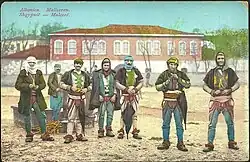Španje
The Španji or Shpani (Cyrillic: Шпањe,Šponje)[a] were a medieval Albanian clan or fis.[1][2] They inhabited the region of Nikšić and the valley of the river Zeta in modern-day Montenegro,[3] while also being widespread around Shkodër and Pult.[4] According to folk legends, they were the oldest tribe in the region, while also being in frequent conflict with many other tribes such as the Macure or Bukumiri. [5] [6][7] They are commonly treated as one of the non-Slavic, "Old Balkanic" people that were assimilated (Slavicized) into the Serb ethnos.[8] Serbianisation of the Španji and other tribes in the region began in the 6th and 7th centuries and according to M. Radovanović (2004) was completed when Serbs from surrounding regions retreated to the mountains of Montenegro and Herzegovina because of the 14th- and 15th century Ottoman invasion.[9]
| Part of a series on |
| Albanian tribes |
|---|
 |
The Špani were quite a rich clan, and their riches flourished in Albania; in the 1416–1417 cadastre of Shkodra many Špani (Shpani) are mentioned, being prevalent in the suburbs of Shkodra and owning land and villages, while also reaping privileges from Venetian possessions.[10]
The Albanian Spani family active in Shkodër and Drivast in the beginning of 14th century originated from the clan.[11] This connection has also been supported by V. Ćorović. The toponyms Španjska gradina (in Spuž) and Španjsko katunište on mount Vražegrmac derive from the tribal name.[12] Š. Kulišić derived their name from Old Greek spanios, meaning 'naked', which might have been used by Greeks for the Illyrian inhabitants of the "naked" karst mountains; similarly, the name Pješivci derives from Slavic plješiv meaning 'bald', and could have been attributed to the inhabitants of those "naked" mountains (in Serbian, the demonym would be golobrđani).[13]
References
- Gashi, Skënder (2015). Onomastic-Historical Research on Extinct and Actual Minorities of Kosova. Ashak. p. 145.
- Sharxhi, Afërdita (2005). "Spanët, Bokalët dhe Marulët sipas botimeve albanologjike" (PDF). Bibliothecae, nr. 6. pp. 42–45.
- Radovanović 2008, p. 52.
- Malaj, Edmond (2003). Noble Families of Medieval Drivasto. Studime Historike. pp. 34–35.
- Kovijanić 1974, p. 43–44.
- GZM 1977, p. 20.
- Barjaktarović 1984, p. 21.
- Radovanović 2004, pp. 110–112.
- Radovanović 2004, p. 68.
- Malaj, Edmond (2003). Noble Families of Medieval Drivasto. Studime Historike. p. 34.
- Gashi, Skënder (2015). Onomastic-Historical Research on Extinct and Actual Minorities of Kosova. Ashak. p. 144.
- Kovijanić 1974, p. 44.
- Kulišić 1980, p. ?.
- Radovanović 2008, p. 101.
Sources
- Barjaktarović, Mirko R. (1984). Rovca: etnološka monografija. CANU.
- — (1977). "Етнолошки преглед". Etnološki pregled [Revue d'etnologie]. Etnološko društvo Jugoslavije. 14.
- — (1977). "Bulletin du Museé de la République Socialiste de Bosnie-Hercegovine à Sarajevo". Glasnik Zemaljskog muzeja BiH: Etnologija. Sarajevo. 32/34.
- Kovijanić, Risto (1974). Crnogorska plemena u kotorskim spomenicima (XIV–XVI vijek) [Montenegrin tribes in Bay of Kotor records (XIV–XVI century)]. Titograd: Istorijski institut SR Crne Gore.
- Kulišić, Špiro (1980). O etnogenezi Crnogoraca (in Montenegrin). Pobjeda. Retrieved 19 November 2011.
- Radovanović, Milovan (2004). Etnički i demografski procesi na Kosovu i Metohiji. Liber Press. ISBN 9788675560180.
- Radovanović, Milovan (2008). Kosovo i Metohija: antropogeografske, istorijskogeografske, demografske i geopolitičke osnove. Službeni Glasnik. ISBN 9788675497806.
- Šobajić, Petar (1996) [1923]. Bjelopavlići i Pješivci. Cid. ISBN 9788649500129.